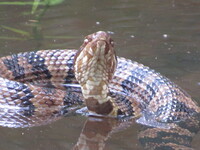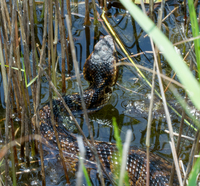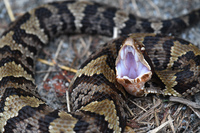Taxonomy
Class: ReptiliaOrder: SerpentesFamily: ViperidaeSubfamily: CrotalinaeOther Common Name(s): Cottonmouth
Taxonomic Comments: Agkistrodon comprises eight species of venomous pitvipers. Most of the diversity of this genus is found within the United States and Mexico, with a couple species ranging south into Central America. Earlier spellings of the genus as "Ancistrodon " are not considered correct. Kraus et al. (1996), among others, showed that "Agkistrodon " in the Eastern Hemisphere are not closely related to those in North America, and revalidated the genus Gloydius for those taxa. Thus, Agkistrodon is restricted to North (and Central) America.Species Comments: Agkistrodon piscivorus , the Northern Cottonmouth, is one of two Agkistrodon (and one of five pitvipers) in North Carolina. It found along the southeastern Coastal Plain, from southern Virginia to northern Florida, west to east Texas and up the Mississippi River. It is absent from higher elevation areas. In North Carolina, Cottonmouths are found in the Coastal Plain and parts of the lower Piedmont. Any records from the western Piedmont or Mountains are likely misidentified Nerodia .A. p. piscivorus , the Eastern Cottonmouth. Molecular systematics have shown clearly that the subspecific identifications are incorrect (Burbrink and Guiher, 2015). Only two species of Cottonmouth are now considered valid, and all populations in North Carolina are referred to A. piscivorus , the Northern Cottonmouth, with no subspecies recognized.Agkistrodon is derived from the Greek ancistron , "fishhook". The specific epithet piscivorus is derived from the Latin picis , "fish", and voro , "to devour" ("fish eater").
Identification
Description: Cottonmouths are large, heavy-bodied pitvipers, with large angular heads distinct from the neck. Coloration is variable; adults can be brown, olive, yellow-ish green, or black, often with distinctly wide crossbands, usually with darker margins and lighter centers. These crossbands are typically widest laterally and may be obscured in larger, older adults. There is a wide, dark postorbital bar extending to the rear of the jaw. The venter is yellow or white, with dark spotting.Morphological Features: Cottonmouths typically have 25 keeled dorsal scale rows. Ventral counts range from 129-137 in NC specimens (Palmer and Braswell, 1995), with 40-50 subcaudals and an undivided anal plate. Head scale counts are typically: 7-8 supralabials, 10-11 infralabials, no loreal, 2 preoculars, 2-3 postoculars and suboculars, 2 nasals, and 3-5 temporals. Palmer and Braswell (1995) noted some variation in scalation across multiple specimens. Technical Reference: Gloyd and Conant (1990); Palmer and Braswell (1995); Ernst and Ernst (2003, 2011); Campbell and Lamar (2004)Field Guide Descriptions: Beane et al. (2010).Online Photos: Google iNaturalist GBIF Observation Methods: Cottonmouths are fairly common across their range in North Carolina, and active both during the day and at night. Many are found basking near water, and occasionally they can be found crossing roads between habitat.
Distribution in North Carolina
County Map: Clicking on a county returns the records for the species in that county.
Key Habitat Requirements
Habitat: Cottonmouths are highly aquatic and are associated with most permanent and semi-permanent bodies of water in the Coastal Plain. The are common in both swamp forests and marshes (Palmer and Braswell, 1995). In the Fall-line Sandhills, they can reach high densities in beaver ponds (Hall, pers. obs.). Beaver ponds are also used in some of the few sites where they have been observed in the Piedmont (Hall, pers. obs.).
Life History and Autecology
Breeding and Courtship: Sexual maturity is reached at body lengths greater than 60 cm. As with the closely related Copperhead, two mating periods are known for Cottonmouths: the first March to June and the second August to October.Reproductive Mode: Cottonmouths are ovoviviparous, giving birth to young enclosed in an amniotic sac; young are typically born in late summer to fall (August to September). Litters average 7 neonates.Aquatic Life History: Cottonmouths are often found in swamps and marshes near rivers, though almost permanent or semipermanent water in eastern North Carolina could likely support them. Work by Dunson and Freda (1985) showed that their skin has low permeability, allowing them to resist desiccation if water bodies begin to dry out.Terrestrial Life History: Cottonmouths are active both day and night, though typically more crepuscular/nocturnal during the hottest months. They are often encountered basking low on logs or stumps along banks, or actively swimming in water or crossing roads between habitats; unlike closely related Copperheads or oft misidentified watersnakes (Nerodia spp.), Cottonmouths do not often climb or bask very high above water. Winter communal hibernation is known, often in rock crevices, roots, hollow logs and stumps. Occurrence records in North Carolina are from every month, and most are from summer and early fall (May–October). 2 ) and one individual having an estimated activity range greater than 600 hectares (Cross, 1998). In Texas, mean home ranges were estimated at approximately 2 hectares for males, 1 hectare for gravid females, and only 0.4 hectares for nongravid females (Roth, 2005). Many home range estimates of Cottonmouths are from populations in Florida, and thus associated with the Florida Cottonmouth (A. conanti ) rather than our native A. piscivorus .
General Ecology
Adverse Environmental Impacts
Status in North Carolina
NHP State Rank: S5Global Rank: G5
Photo Gallery for Agkistrodon piscivorus - Northern Cottonmouth 25 photos are shown. Recorded by: Becky Elkin, Mark Basinger and Jim Petranka Recorded by: F. Williams, S. Williams, P. Hart Recorded by: H. Talcott Recorded by: Z. Lunn Recorded by: Erich Hofmann Recorded by: Erich Hofmann Recorded by: Erich Hofmann, Kayla Weinfurther, and Rhett Rautsaw Recorded by: Paul Hart Recorded by: C. Hinson Recorded by: C. Hinson Recorded by: C. Hinson Recorded by: J. Cox Recorded by: Erich Hofmann and Kayla Weinfurther Recorded by: L. Purvis Recorded by: Erich Hofmann and Paul Hofmann Recorded by: Mark Shields Recorded by: F. Williams, S. Williams Recorded by: Erich Hofmann Recorded by: Erich Hofmann Recorded by: Erich Hofmann Recorded by: Mark Shields Recorded by: Erich Hofmann and Allegra Hodges Recorded by: Steve Hall, Mike Schafale, Scott Pohlman, Richard LeBlond and John DeLucca Recorded by: Erich Hofmann Recorded by: Steve Hall

 »
» 



 »
» 

